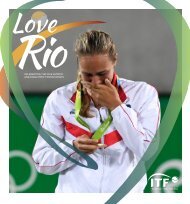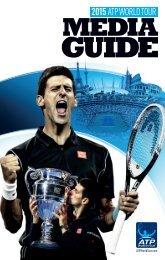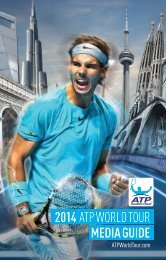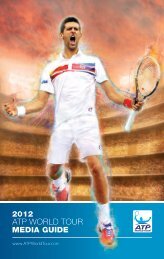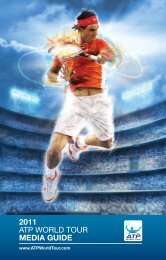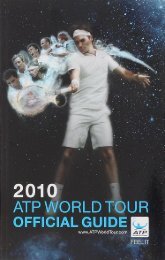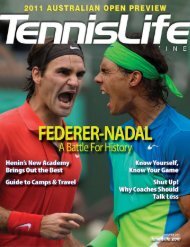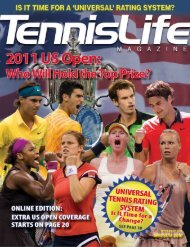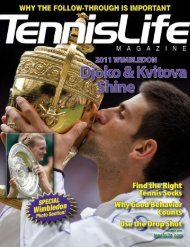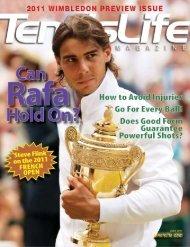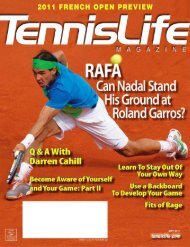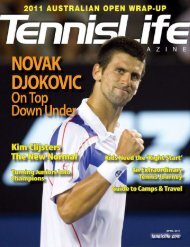A Champion's Mind - Pete Sampras
www.tennismoscow.me Insta:TENNISMOSCOW
www.tennismoscow.me Insta:TENNISMOSCOW
Create successful ePaper yourself
Turn your PDF publications into a flip-book with our unique Google optimized e-Paper software.
Over the years, I had to answer the call against a staggering array of rivals—dangerous players who<br />
were capable of giving me fits and worse. Some of their names might surprise you. And some of them may<br />
not have been given their due, or their full measure of credit, elsewhere in this book. There were also<br />
some impact players in my era who just didn’t figure heavily into my career high—or low—points. I’m<br />
including them as well, to try to give you an all-around sense of how I felt about most of the important<br />
players of my time. They’re listed alphabetically by name, and I’m adding my head-to-head record against<br />
each man, along with my comments.<br />
BORIS BECKER (12–7) . . . Like Goran Ivanisevic, Boris could go toe-to-toe with me on grass or fast<br />
surfaces because of his big serve. But overall, I felt I did everything just a smidgen better than Boris did.<br />
It was that simple. I didn’t have any secret or special tactics. I knew we would go out and trade<br />
thunderbolts, and the player who was serving better, feeling the ball better, and playing with more<br />
confidence probably would win.<br />
Two of Boris’s biggest assets were his personality and his ego. He was a hugely charismatic guy, and<br />
he also walked with a swagger, especially at Wimbledon. He was such an icon in his own time that<br />
journeymen were intimidated by his very presence. But there was no intimidation and certainly no<br />
animosity or mind games when we played. We respected each other, and that showed in the spirit and tone<br />
of our matches. Our rivalry was always about good, power-based attacking tennis—and little else.<br />
SERGI BRUGUERA (2–3) . . . He’s one of the few guys I played more than once or twice who finished with<br />
a positive head-to-head against me. He once beat me on hard courts, I once beat him on clay. People<br />
tended to deride and dismiss Bruguera as a clay-court grinder, but he was better than that. He posed<br />
special problems that lifted him a healthy notch above the other baseliners. Sergi played from way back,<br />
which made him vulnerable to attack, but the guy moved like a deer. He was one of the best movers ever,<br />
and he could get to anything and take a good whack at it with a heavy, topspin forehand.<br />
MICHAEL CHANG (12–8) . . . When we were juniors, Michael was the gold standard, and he really<br />
punished me when I abandoned the two-handed backhand. So I developed a mental block against Michael<br />
that lasted for quite a while. But also, right through my early years as a pro, I could be a little inconsistent,<br />
and that was the one unforgivable sin when you played Michael.<br />
In those early years, Michael often made me hit that one extra ball that teased out an error, but over<br />
time, I became more consistent and I developed more power. Michael then became a kind of litmus test<br />
for me. If I was playing well, I could control and overpower him.<br />
I beat Michael in one match that was absolutely huge—for him. That was the 1996 U.S. Open final. He<br />
was in the running for the number one ranking and it was his best chance to win a second major, thereby<br />
shedding the one-slam wonder label that some people applied to him. That label was unfair, of course,<br />
because of Michael’s great consistency. He was always in the mix at the top of the game, where a true<br />
one-slam wonder tends to pop up out of nowhere—and go back there after making his stunning statement.<br />
JIM COURIER (16–4) . . . Jim was an interesting case because there were definitely strategic, tactical things



